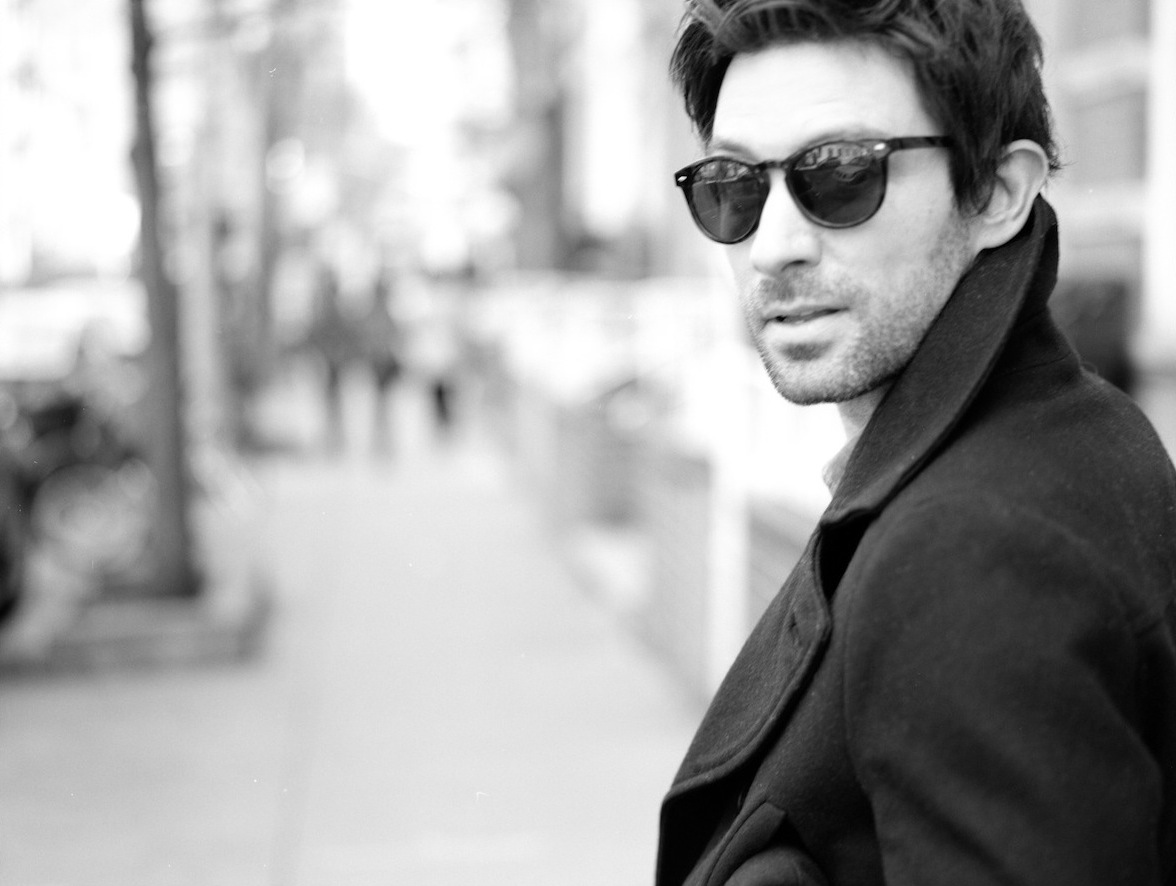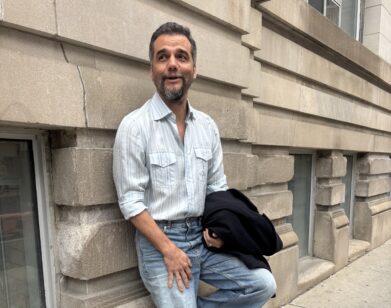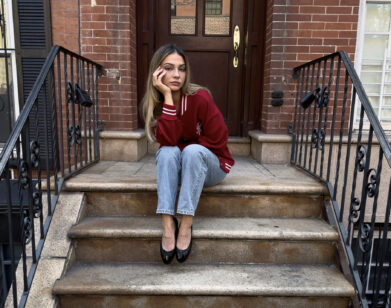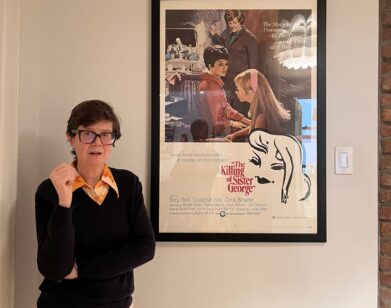How Shane Carruth Constructs

ABOVE: SHANE CARRUTH. PHOTO BY CHRISTOPHER GABELLO
People obsessively make things in Shane Carruth’s movies. They are often isolated individuals. Whether it’s taking apart electronics in the garage to build a homemade time machine, as in his 2004 film Primer, or any number of unusual DIY activities in his new film Upstream Color—from making paper chains, to making drugs from strange white worms, to collecting sounds for avant-garde music.
It’s a motif that dovetails with Carruth’s own biography: he’s someone who came to filmmaking on his own, and learned to wear all the hats himself. His films are meticulous constructions that retain the quality of a handmade object. He famously taught himself 16mm cinematography for Primer, which he made for $7,000, and shot each scene in one take. He also does his own visual effects, and some of the most striking sequences in his latest film may recall the swirling scenes of the nascent cosmos in The Tree of Life.
Upstream Color stars Amy Seimetz and Carruth as Kris and Jeff, two people drawn together by unique trauma and linked by a third mysterious figure, known only as The Sampler. The film’s plot begins with abduction, and weaves together financial fraud, Thoreau’s Walden, a mysterious drug, collective hypnosis, genetic transformation, and orchid-hunters. It’s an existential sci-fi thriller that doesn’t so much present a singular story as put forward a constellation of possible narrative strands.
Sharing some formal correspondences with Harmony Korine’s Spring Breakers, Upstream Color is an immersive film that foregrounds texture and atmosphere, and often moves into the realm of pure visual and sonic storytelling, where dialogue is minimized, and often oblique. (Carruth also produced the synth-heavy score.) The film’s rhythms are disorienting and unsettling, but for the intrepid moviegoer, it offers a singular experience—a paranoid head-trip punctuated with moments of transcendence.
On the eve of the film’s screening at New Directors/New Films, Shane sat down with us for a heady discussion on the film’s origins, finding an audience, and non-verbal communication.
PAUL DALLAS: The film has just had its New York premiere this week. How has the reception been here?
SHANE CARRUTH: The bottom line is, the first time anyone saw the film was January at Sundance. I’ve been traveling around with it, and it’s played Berlin and SXSW, and we’ve done these awareness screenings in Seattle and LA and all these other places. This film was always going to be divisive in some way, simply because it has an ambition that is a bit different. So there will always be some people who key into what its ambitions are and what its intent is, and they’ll judge it based on that. But in general, it’s definitely leaning toward the positive. If January was the beginning of a conversation that’s making people aware of what the film’s up to, I don’t think anyone’s walking into Upstream Color now without knowing roughly the arena it’s trying to engage them in.
DALLAS: It’s astonishing that you managed to make this film in relative secrecy. It’s a rarity in this day and age.
CARRUTH: Yeah, it is. I’m realizing that now. It was done only because I’d tried to get this project made called A Topiary, and even though I’m nobody from nowhere, the script found its way online. It was being read and reviewed. It was really anxiety-inducing. So [that experience] definitely made me want to keep things quiet on Upstream Color—or as quiet as they can be. When there’s a finished film to be seen, then let’s let people know that it exists.
DALLAS: You’re distributing the film yourself. What does that mean?
CARRUTH: In some ways, we’re not really doing anything different than what a distributor would do. We’re tying to use these great [festivals and venues] to draw attention to the film and raise awareness. There was no way to be sure that a distributor would have been willing to communicate [the film’s message] to the public. My intention is not to make every last dollar I can. It’s to let the people who are potentially going to be receptive to the film know that it’s available for them and [to tell them] roughly what it is, so there isn’t any bait and switch happening.
DALLAS: Paul Thomas Anderson went a similar route with The Master. It was the first film where he personally controlled the graphic design of the advertising and cut the trailers.
CARRUTH: Yeah, I was so inspired by that.
DALLAS: I won’t ask you to describe what the film is about, but what are some of the points of origin for Upstream Color?
CARRUTH: It really started with this notion of personal identity. I wanted to explore how it comes to be—whether it’s a cemented thing or not, whether behavior dictates our worldview or the other way around. With Kris [played by Amy Seimetz], I wanted to strip her and have her be forced to rebuild [her identity]. That was the kernel of how this all started. It’s an exploration of all the ideas we’ve built up to try to explain why we do the things we do, why events look like they’re transpiring, why the world we sees us in a certain way. I wanted to take that all away and have it rebuilt. The film is this bizarre life cycle.
DALLAS: There’s definitely a sense that Kris and Jeff are caught up in certain larger systems beyond their control. At the same time, the film stays very close to individual experience.
CARRUTH: I think I had a cynical view of this idea of identity. [I assumed] that our political and religious beliefs are all formed at some point, and that we keep repeating those [initial] beliefs, and that they dictate everything—how we vote, how we see each other, how our relationships work, all of that. And I think I had this view that, if you could strip away all that subjectivity, strip away everything you’d learned or that you’d been taught or accumulated, that maybe underneath would be this core—that would be plurality of thought, that would be the ability to be malleable to circumstances instead of having a predefined understanding of them. Eventually [it] lead to the idea that maybe there wasn’t anything inside, that maybe we are just an accumulation of these subjective key points of experience. That’s the bit that started to make this whole thing horrific, this idea that you’re not left with anything, that you’re just a lost consciousness in the world.
DALLAS: Kris’s abductor makes her copy pages from Thoreau’s Walden. I thought about how Primer and Upstream Color are both films about agency, which is related Thoreau’s idea of self-reliance.
CARRUTH: It may be a fool’s errand, but I think half a recipe for a narrative has got to be the exploration [and] the other half is to be compelling on the minute-by-minute basis. We’ve got to give some reason for the audience to pay attention, or else we have a dry doctoral thesis of ideas that nobody would really want to read or sift through. When you’re talking about agency, I immediately go to the fact that that is what’s compelling to me. I enjoy processes. I enjoy trying to understand what I would do in those circumstances. I like [characters] trying to earn something or have a goal. That’s my version of a gunfight or fight sequence.
DALLAS: Were you a big fan of procedural movies or TV shows like Law & Order or MacGyver?
CARRUTH: I never got into MacGyver, but All the President’s Men and The Conversation were big for me. What I keyed into on those films was realizing that I’m really captivated by watching [characters] just do their job. It served as a gateway into knowing them. Probably the TV show I’ve watched the most is How It’s Made on the History Channel. I could watch 24 hours of How It’s Made and never get bored. Or Dirty Jobs—that’s even better!
DALLAS: One of the most fascinating aspects of Upstream Color is the narrative structure. How did you arrive at the structure?
CARRUTH: Part of it is just my own aesthetic and how I like to deliver information. But then another part of it is that I thought about [the narrative] in thirds. In the first third, we’re putting Kris through the process of how this world works and everything about it is more or less about control. We’ve got these lockdown shots, and it’s as objective and as straightforward as this film is likely to get. In the middle third, the film takes on a much more subjective tone, because at this point, we’re dealing with [characters] who have been “processed.” Because [the characters] can’t talk about it, I need to be able to use every non-verbal tool I can with film language in order to be able to convey something about their experience. If I was the sort [of director] who would use POV shots, that’s where I would use them. But instead, we use music and cinematography to convey this lost sense, and this fragmented existence that [Kris and Jeff] share. In the final third, the whole thing just comes off the rails completely and flips over, and we are in a world of subtext and motivation, and almost nothing else. The language of the storytelling has to match that. It becomes less and less important to talk about anything and more and more important to stay silent. If we talk, we’re going to break the spell, in a way.
DALLAS: Film and music share a similar ability to tap into emotional spaces that are beyond words. Upstream Color feels especially musical in its composition.
CARRUTH: I was writing the music while I was writing the script. But I made a mistake and didn’t realize it until we got close to production, which is that half of [the music] I’d written was trying to frame the mind of the audience, but wasn’t conveying the experience of the characters onscreen. For whatever reason, it didn’t occur to me until the visual language had been cemented and was doing a decent job of conveying [this]. I realized I needed to change the music, so I had to write the other half [of the score] while in production and a little bit in post-production. So much of the film is non-verbal, and what’s happening is suggested but not said outright.
DALLAS: You’re able to communicate a lot of the story elements without dialogue.
CARRUTH: Amy coming onboard and giving such a wonderful performance meant that I could lean on her a bit more and lean away from these other tools. There’s that sequence where Kris is in her workplace, Jeff is in his workplace, and The Sampler is sampling sounds. Originally, there was a version of that scene that was visually connected them. Kris would be at lunch downtown and her hand would get closer and closer to this sculpture of a cityscape and closer and closer to a building without her knowing, and we’d push into that sculpture of the building and we’d match the actual building Jeff would be working in. It would be this series of visual matches that would let us know that they are connected without knowing they’re connected. As we got closer to production, I felt like I could step back and make the connections sonic. The Sampler has a career in the world of music, which meant that we can have him be the missing link connecting [Kris and Jeff], and the droning of workplace sounds that will communicate that connection.
DALLAS: Tell me about the collaboration with David Lowery, your editor. He directed All Them Bodies Saints, which also premiered at Sundance alongside Upstream Color.
CARRUTH: I feel like I got so lucky. I met David Lowery with his producers a few weeks before we started shooting. All I knew about him was that they seemed like really great people. I didn’t know anything about the Dallas film community and I got very behind in editing. I was loosing sleep and parts of production were slipping because I couldn’t edit fast enough, so I asked him to please take a look at the work.
DALLAS: You’re editing as you’re shooting, which is a lot. But you’re also directing and starring in the film, and there are only 24 hours in a day.
CARRUTH: That’s true, and that’s what it was. I was only sleeping like 90 minutes a day! Everything was falling apart! I asked David to come in, and he just sort of saved my life. I didn’t expect it to work out nearly as well as it did. There’s two things: he innately understood [the film], but at the same time we had lots of long conversations that made me confident that he really got it. He took what I’d already edited and the new material and seamlessly edited together things that were totally perfect. Once shooting was done, we were able to work together in the house for a couple weeks. His ideas are in [the film] as well—it was just a really great collaboration.
DALLAS: What for you has been the most significant change in the landscape of independent filmmaking since 2004, when Primer debuted, and now?
CARRUTH: I can speak about it from the standpoint of distribution. Because we’re moving away from physical media and into digital, and that’s where most of the awareness exists, and where the audience exists for a film, it’s an easier prospect, financially. I feel that there are more opportunities now to drive the contextualization of how a film is received and to benefit from the revenue. Hopefully, that revenue will go back into making films.
DALLAS: Steven Soderbergh has been one of your champions. What do you think of his much-publicized departure from filmmaking, and the idea that traditional cinema is over?
CARRUTH: All I know is that as an audience member, I am less and less inclined to go to the theater. But that has to do with content and also because the venues seem to be actively trying to repel people.
DALLAS: I agree. You’re now based in New York. How do you like it?
CARRUTH: I am, yes. I’ve been here for about a year now. It’s great. I don’t know why I waited so long to move here!
DALLAS: And you also have a new project in the works.
CARRUTH: Yes, I’m finalizing the script now. It’s called The Modern Ocean. I’ve got to solve the money. We can’t repeat the same shoot that we had for Upstream Color—it was too taxing. You pay a price, one way or another, whether it’s in money or in sweat and sleepless nights.
DALLAS: Is the story set in New York?
CARRUTH: There’s about five minutes set in New York. It’s actually set all over the world, in all sorts of remote places. It’s about shipping routes and trading commodities, pirates and privateers. It’s a tragic romance. I really can’t wait. It’s going to be a good thing.
UPSTREAM COLOR OPENS IN NEW YORK AT IFC CENTER ON APRIL 5.






